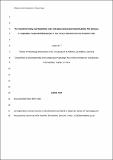Files in this item
The "avoid the empty cup" hypothesis does not explain great apes’ (Gorilla gorilla, Pan paniscus, P. troglodytes, Pongo abelii) responses in two three-cup one-item inference by exclusion tasks
Item metadata
| dc.contributor.author | Call, Josep | |
| dc.date.accessioned | 2022-07-07T16:30:16Z | |
| dc.date.available | 2022-07-07T16:30:16Z | |
| dc.date.issued | 2022-06-30 | |
| dc.identifier | 279528259 | |
| dc.identifier | 33f062b7-92f8-4bcf-aeba-d1028c0a5d5a | |
| dc.identifier | 85134015232 | |
| dc.identifier | 000818072400001 | |
| dc.identifier.citation | Call , J 2022 , ' The "avoid the empty cup" hypothesis does not explain great apes’ ( Gorilla gorilla, Pan paniscus, P. troglodytes, Pongo abelii ) responses in two three-cup one-item inference by exclusion tasks ' , Journal of Comparative Psychology , vol. Advance online . https://doi.org/10.1037/com0000321 | en |
| dc.identifier.issn | 0735-7036 | |
| dc.identifier.other | ORCID: /0000-0002-8597-8336/work/115631012 | |
| dc.identifier.uri | https://hdl.handle.net/10023/25630 | |
| dc.description.abstract | In the two-cup one-item task, subjects are shown a food item, which is then hidden inside one of two cups. Several species spontaneously select the baited cup above chance levels if shown that the other cup is empty. Although this response may indicate inference by exclusion (if not A, then B), another possibility is that subjects simply avoid choosing the empty cup, not because they expect the food to be in the other cup but because they have seen that cup to be empty. I tested whether this hypothesis explains great apes’ responses in a three-cup one-item task. Subjects saw three opaque cups on a platform, with two of them located behind a barrier during baiting. After baiting one of the cups behind the barrier, I revealed the identity of the empty cup that had been located behind the barrier (Experiment 1) or revealed the contents of the center cup (baited in half of the trials), but always removed it before the subjects’ choice (Experiment 2). In Experiment 1, subjects preferentially selected the baited cup even though one of the other two cups had not been shown to be empty. In Experiment 2, subjects’ preference for the cup that had been located behind the barrier during baiting was modulated by the contents of the removed cup. These results suggest that expectations about the food’s location, not just the sight of the empty cup, as postulated by the “avoid the empty cup” hypothesis, determine apes’ responses in the three-cup one-item task. | |
| dc.format.extent | 705010 | |
| dc.language.iso | eng | |
| dc.relation.ispartof | Journal of Comparative Psychology | en |
| dc.subject | Disjunctive syllogism | en |
| dc.subject | Inference by exclusion | en |
| dc.subject | Proto-logic | en |
| dc.subject | Object permanence | en |
| dc.subject | Expectations | en |
| dc.subject | Object search | en |
| dc.subject | BF Psychology | en |
| dc.subject | NDAS | en |
| dc.subject.lcc | BF | en |
| dc.title | The "avoid the empty cup" hypothesis does not explain great apes’ (Gorilla gorilla, Pan paniscus, P. troglodytes, Pongo abelii) responses in two three-cup one-item inference by exclusion tasks | en |
| dc.type | Journal article | en |
| dc.contributor.institution | University of St Andrews. Centre for Social Learning & Cognitive Evolution | en |
| dc.contributor.institution | University of St Andrews. School of Psychology and Neuroscience | en |
| dc.contributor.institution | University of St Andrews. Institute of Behavioural and Neural Sciences | en |
| dc.identifier.doi | 10.1037/com0000321 | |
| dc.description.status | Peer reviewed | en |
This item appears in the following Collection(s)
Items in the St Andrews Research Repository are protected by copyright, with all rights reserved, unless otherwise indicated.

